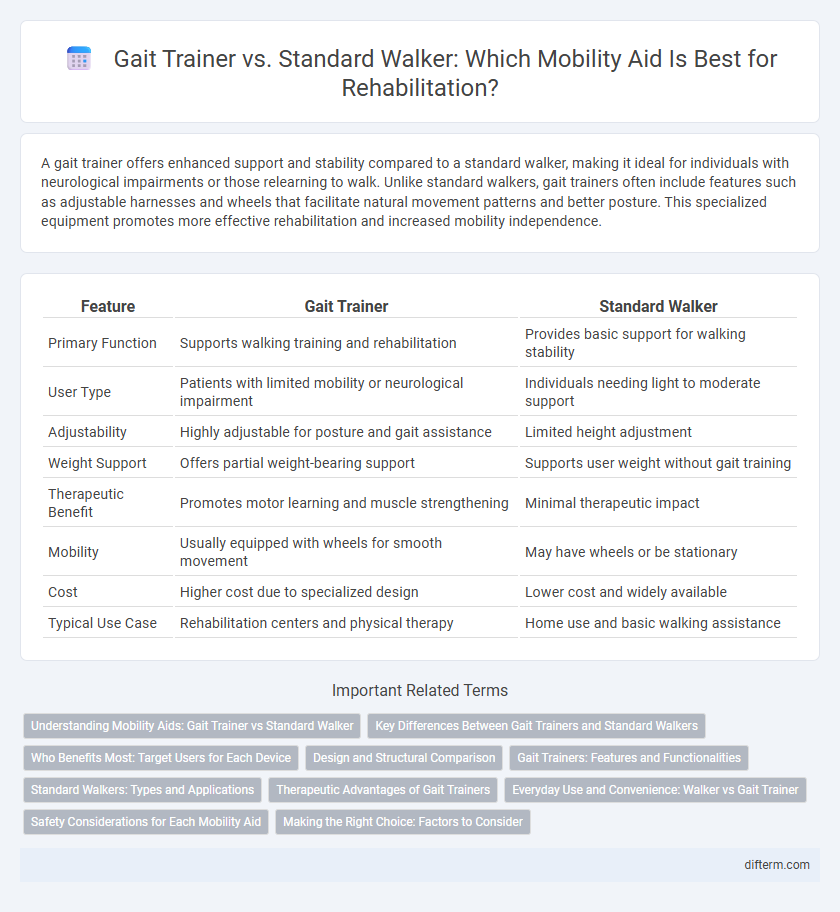A gait trainer offers enhanced support and stability compared to a standard walker, making it ideal for individuals with neurological impairments or those relearning to walk. Unlike standard walkers, gait trainers often include features such as adjustable harnesses and wheels that facilitate natural movement patterns and better posture. This specialized equipment promotes more effective rehabilitation and increased mobility independence.
Table of Comparison
| Feature | Gait Trainer | Standard Walker |
|---|---|---|
| Primary Function | Supports walking training and rehabilitation | Provides basic support for walking stability |
| User Type | Patients with limited mobility or neurological impairment | Individuals needing light to moderate support |
| Adjustability | Highly adjustable for posture and gait assistance | Limited height adjustment |
| Weight Support | Offers partial weight-bearing support | Supports user weight without gait training |
| Therapeutic Benefit | Promotes motor learning and muscle strengthening | Minimal therapeutic impact |
| Mobility | Usually equipped with wheels for smooth movement | May have wheels or be stationary |
| Cost | Higher cost due to specialized design | Lower cost and widely available |
| Typical Use Case | Rehabilitation centers and physical therapy | Home use and basic walking assistance |
Understanding Mobility Aids: Gait Trainer vs Standard Walker
Gait trainers provide enhanced support and promote proper walking patterns through adjustable harness systems and balanced weight distribution, making them ideal for individuals with significant mobility impairments or neurological conditions. Standard walkers offer stability and assistance for users who require basic support during ambulation but have adequate balance and strength to maintain an upright posture independently. Selecting the appropriate mobility aid improves patient safety, encourages functional mobility, and facilitates rehabilitation tailored to specific physical needs.
Key Differences Between Gait Trainers and Standard Walkers
Gait trainers provide dynamic support and assistance to improve walking patterns, featuring adjustable harnesses and trunk support, while standard walkers offer basic stability with fixed frames and hand grips. Unlike standard walkers, gait trainers promote weight shifting and muscle strengthening through guided movement, making them ideal for rehabilitation and therapy. Standard walkers are typically used for individuals requiring minimal support and more independence during ambulation.
Who Benefits Most: Target Users for Each Device
Gait trainers primarily benefit individuals with neurological impairments such as cerebral palsy, stroke, or spinal cord injuries who require support to improve their walking patterns and stability. Standard walkers are most suitable for elderly users or those with general mobility limitations needing balance assistance during short-distance ambulation. Patients with moderate to severe gait abnormalities typically gain greater functional improvements from gait trainers due to their enhanced posture control and therapeutic features.
Design and Structural Comparison
Gait trainers feature an ergonomic design with adjustable support systems that promote natural walking patterns, while standard walkers typically have a rigid frame offering basic stability. Structurally, gait trainers incorporate harnesses and pelvic supports to enhance user posture and reduce the risk of falls, contrasting with standard walkers that rely on user balance and arm strength. The advanced design elements in gait trainers facilitate improved mobility and rehabilitation outcomes compared to the conventional, simpler construction of standard walkers.
Gait Trainers: Features and Functionalities
Gait trainers offer advanced support with adjustable harnesses and ergonomic designs that promote proper posture and balance during ambulation, unlike standard walkers which provide basic stability. They incorporate features such as weight-bearing assistance, multi-directional wheels for smoother navigation, and customizable support levels tailored to individual rehabilitation needs. These functionalities enhance mobility training outcomes by encouraging correct gait patterns and muscle strengthening in patients with neurological or physical impairments.
Standard Walkers: Types and Applications
Standard walkers, including wheeled, folding, and platform types, provide essential support for individuals with varying mobility needs, improving balance and stability during ambulation. These devices are widely applied in rehabilitation settings for elderly patients, those recovering from surgery, or individuals with neuromuscular disorders to enhance safe movement. The choice of standard walker type depends on the user's strength, coordination, and specific functional goals to optimize mobility and independence.
Therapeutic Advantages of Gait Trainers
Gait trainers provide enhanced therapeutic benefits compared to standard walkers by promoting proper walking patterns and improving muscle strength, balance, and coordination. These devices enable controlled weight-bearing and posture alignment, essential for neurorehabilitation and recovery in conditions like stroke or cerebral palsy. The adjustable support and assistive feedback of gait trainers facilitate higher functional mobility outcomes and greater patient confidence during therapy sessions.
Everyday Use and Convenience: Walker vs Gait Trainer
Gait trainers offer enhanced support and stability for users needing assistance with walking patterns, making them ideal for therapeutic and rehabilitation settings rather than everyday use. Standard walkers, with their lightweight design and foldable features, provide greater convenience and portability for routine mobility tasks and frequent transfers. Users seeking practical assistance for daily activities often prefer standard walkers due to their ease of handling and compatibility with various environments.
Safety Considerations for Each Mobility Aid
Gait trainers offer enhanced safety through built-in support features such as chest pads, harnesses, and adjustable frames that promote correct posture and reduce fall risk for individuals with severe mobility impairments. Standard walkers provide stability with four contact points and hand grips but require significant user balance and strength, making them less suitable for those with high fall risk or poor coordination. Selecting the appropriate mobility aid depends on individual assessments of balance, strength, and specific safety needs to minimize injury and enhance confident movement.
Making the Right Choice: Factors to Consider
Choosing between a gait trainer and a standard walker depends on the user's mobility level, balance needs, and rehabilitation goals. Gait trainers provide enhanced support and stability for individuals with significant mobility impairments, promoting proper gait patterns during therapy. Standard walkers are better suited for those with mild balance issues requiring moderate assistance during daily activities.
Gait trainer vs Standard walker Infographic

 difterm.com
difterm.com